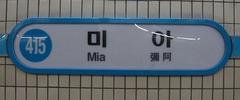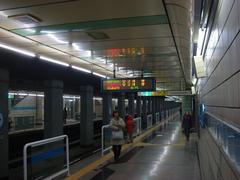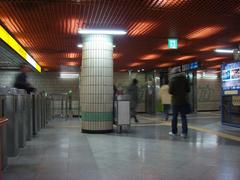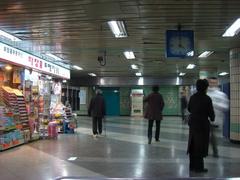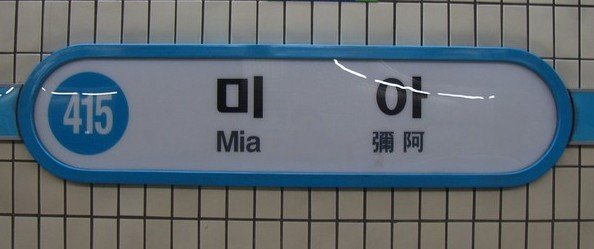
Mia Station Visiting Hours, Tickets, and Comprehensive Guide to Seoul’s Historical Sites
Date: 15/06/2025
Introduction: Mia Station’s Role in Seoul’s Urban Fabric
Mia Station, located in the lively Mia-dong neighborhood of Gangbuk-gu, serves as a vital connector between Seoul’s historical past and vibrant present. As a prominent stop on Seoul Subway Line 4, Mia Station is more than a transit hub—it’s your entry point to authentic local experiences, cultural landmarks, and scenic urban escapes in northern Seoul. This guide explores Mia Station’s history, significance, practical visitor information, and its proximity to must-see attractions like Hyehwamun Gate, Dream Forest, and Bukhansan National Park. Whether you’re a first-time visitor or a daily commuter, you’ll find essential tips here for navigating Mia Station and its surroundings with ease.
For planning your itinerary and accessing official resources, visit Seoul Metro and the Seoul Tourism Official Website.
Table of Contents
- Mia Station Overview
- Practical Visitor Information
- Getting There and Local Transportation
- Nearby Attractions
- Tips for Visitors
- Visual and Interactive Resources
- Frequently Asked Questions (FAQ)
- Hyehwamun Gate: History & Visiting Guide
- Mia Station Connectivity & Transportation
- Exploring Mia-dong: Neighborhood Insights
- Key Local Attractions
- FAQ
- Conclusion
- References and Further Reading
Mia Station: Your Gateway to Northern Seoul
Overview
Situated in Mia-dong, Gangbuk-gu, Mia Station is a strategic node on Seoul Subway Line 4. It provides direct access to both residential neighborhoods and major city attractions, serving as a bridge between local life and the broader Seoul metropolitan area.
Practical Visitor Information
- Operating Hours: Daily from approximately 5:30 AM to midnight. Last trains depart around 11:45 PM. Night buses operate beyond subway hours for continued city access.
- Tickets and Fares: Single-ride tickets and T-money cards are available at station kiosks and convenience stores. Fares start at 1,350–1,400 KRW (about $1.10 USD), with incremental increases for longer distances.
- Climate Card Tourist Pass: Launching July 2025, this pass allows unlimited subway and bus rides for 1, 2, 3, or 5 days—ideal for visitors (InMyKorea).
- Accessibility: The station features elevators, escalators, tactile paving, and barrier-free exits. English, Chinese, and Japanese signage make navigation easy for international travelers.
- Station Facilities: Clean restrooms, convenience stores, waiting areas, and multiple exits connect to bus stops, shops, and community centers.
Getting There and Around
Mia Station’s integration with Subway Line 4 offers swift connections to major districts like Dongdaemun, Myeongdong, and Seoul Station. Bus stops adjacent to the station provide further connectivity to areas not served by the subway. The upcoming Dongbuk Light Rail will enhance accessibility even more.
Nearby Attractions and Things to Do
Mia-dong Markets
Experience authentic Korean life at local markets, where you’ll find fresh produce, street food, and handmade goods.
Community Parks
Enjoy urban green spaces designed for relaxation and community events—perfect for a peaceful stroll or a family picnic.
Cultural & Historical Sites
Visit significant landmarks such as Hyehwamun Gate, a relic of the Joseon Dynasty, and explore nearby temples and museums.
Cafes and Dining
From cozy coffee shops to bustling Korean BBQ restaurants, Mia-dong offers diverse dining options. Don’t miss local specialties like kalguksu and bingsu.
Tips for Visitors
- Navigation: Download KakaoMap or Naver Map for real-time transit updates and English support.
- Tickets: Use a T-money card or Climate Card Tourist Pass for convenient fare payment across buses and subways.
- Timing: Visit on weekdays or outside peak hours (early morning or late evening) for a more relaxed experience.
- Station Exits: Take advantage of multiple exits to explore different sectors of Mia-dong.
Visual and Interactive Resources
Explore virtual tours and up-to-date maps on the Seoul Metro website and local tourism portals. High-resolution images and interactive maps help you plan your journey efficiently.
Frequently Asked Questions (FAQ)
Q: Are guided tours available near Mia Station?
A: While the station itself doesn’t offer tours, nearby tourism centers can arrange guided visits to Gangbuk-gu’s key sites.
Q: Is Mia Station safe for tourists?
A: Yes, it is monitored by security personnel, CCTV, and is well-lit. Seoul’s public transit is globally renowned for its safety.
Q: Can I purchase attraction tickets at Mia Station?
A: Subway ticket counters are for transit only. For attraction tickets, visit official sites or nearby tourist centers.
Q: What are the best times to visit?
A: Early mornings and late evenings are less crowded, making for a pleasant visit.
Hyehwamun Gate: History & Visitor Guide
Introduction
Hyehwamun Gate, also known as the Northeast Gate of the Seoul Fortress Wall, stands as a prominent reminder of Seoul’s defensive history and architectural heritage from the Joseon Dynasty. Located near Mia Station, it’s a must-see for history buffs and photographers alike.
Historical and Cultural Significance
Originally constructed in 1396, Hyehwamun Gate was integral to Seoul’s city walls. Though it has been restored multiple times, its design remains true to traditional Korean architecture and the spirit of the Joseon period.
Location and Accessibility
Located just a 20-minute walk or short bus ride from Mia Station, the gate is surrounded by scenic paths along the Fortress Wall.
Visiting Hours and Admission
- Hours: 5:00 AM – 10:00 PM, year-round.
- Admission: Free.
Guided Tours and Special Events
Local organizations and Seoul city tourism centers frequently offer guided walking tours that provide historical context and highlight the gate’s features. On traditional holidays like Chuseok and Lunar New Year, cultural events and reenactments are held at the site.
Photographic Spots and Visitor Tips
- Best Times: Early morning or late afternoon for optimal lighting.
- Accessibility: The area is wheelchair-friendly, with paved paths and ramps.
- Photo Opportunities: Capture panoramic views of the Fortress Wall and traditional rooftops.
Nearby Attractions
After visiting Hyehwamun, explore Korea University, Sungshin Women’s University, and the vibrant neighborhoods of Samyang and Hwagye, known for their markets and cafes.
Mia Station Connectivity & Transportation Guide
Subway and Bus Integration
Mia Station, while not an interchange, links efficiently to major transfer points like Dongdaemun History & Culture Park and Seoul Station. Real-time train information, clear English signage, and frequent service support smooth journeys (TravelPander, MetroLineMap).
City buses (blue, green, yellow, red) serve nearby stops, expanding travel options to less central areas.
Airport and Intercity Access
Reach Mia Station from Incheon International Airport via AREX to Seoul Station, then transfer to Line 4 (approx. 70–80 minutes). Limousine buses and private transfers are also available. Seoul Station connects to KTX high-speed trains for nationwide travel (InMyKorea).
Digital Tools & Real-Time Info
Apps like KakaoMap, Naver Map, and KakaoMetro offer real-time schedules and route planning, while electronic boards at Mia Station provide live updates.
Safety, Cleanliness, and Operating Hours
Mia Station and Seoul’s transit system are renowned for their cleanliness, safety, and reliability. CCTV, emergency call buttons, and visible staff presence ensure peace of mind.
Practical Travel Tips
- Buy a T-money or Climate Card Tourist Pass for unlimited travel.
- Use real-time navigation apps for route planning.
- Check electronic boards for updates.
- For late-night travel or last-mile journeys, use taxis or ride-hailing apps like Kakao T.
Exploring Mia-dong: Neighborhood Insights
Mia-dong stands out for its serene residential feel, bustling local businesses, and community-focused events. It offers a slice of everyday Seoul life away from the crowds of downtown.
Key Local Attractions
Dream Forest (북서울 꿈의숲)
- Hours: 5:00 AM – 10:00 PM
- Admission: Free (some exhibitions may require tickets)
- Highlights: Panoramic observatory, walking trails, art center
Samgaksan & Bukhansan National Park
- Hours: Open 24/7 (recommended to hike during daylight)
- Admission: Free
- Highlights: Striking city views, challenging trails, historic temples
Mia Sageori Shopping & Dining
- Hours: Most shops and restaurants from 10:00 AM – 10:00 PM
- Highlights: Lotte Department Store, street food, local boutiques
Local Markets & Eateries
- Best Times: Late afternoon to evening for the most vibrant atmosphere
- Try: Tteokbokki, kalguksu, mandu, and bingsu
Educational Institutions
- Visit community centers for exhibitions and events; find student-friendly cafes near Seoul National University of Education’s Mia Campus.
Frequently Asked Questions (Neighborhood)
Q: What are Mia Station’s operating hours?
A: 5:30 AM to midnight daily.
Q: How do I buy tickets?
A: At station kiosks, vending machines, or convenience stores. T-money cards are recommended.
Q: Is Mia Station wheelchair accessible?
A: Yes, with elevators, escalators, and accessible exits.
Q: Are Dream Forest and Bukhansan National Park free?
A: Yes. Special exhibitions or events may charge a fee.
Q: What local foods should I try?
A: Tteokbokki, kalguksu, mandu, and bingsu are popular choices.
Visual Resources
For detailed maps, virtual tours, and up-to-date travel information, consult the Seoul Metro website and reputable platforms such as Namu Wiki and TripSavvy.
Summary Table: Hyehwamun Gate Overview
| Feature | Details |
|---|---|
| Monument Name | Hyehwamun Gate |
| Location | Mia-dong, Gangbuk-gu, Seoul |
| Historical Era | Joseon Dynasty (built 1396) |
| Visiting Hours | 5:00 AM – 10:00 PM |
| Admission Fee | Free |
| Accessibility | Wheelchair-accessible pathways and ramps |
| Guided Tours | Available via local cultural organizations |
| Nearby Attractions | Korea University, Sungshin Women’s University, Samyang, Hwagye |
For more, see Seoul Tourism Official Website and Mapcarta.
Conclusion
Mia Station is a dynamic hub that combines efficient transportation, cultural richness, and local charm. Its strategic location provides easy access to historical landmarks, scenic parks, and bustling markets, all while offering robust accessibility and digital navigation tools. Whether you’re seeking Seoul’s hidden gems or simply looking for a seamless transit experience, Mia Station and Mia-dong deliver a rewarding visit.
Download the Audiala app for real-time navigation, guided tours, and exclusive content on Seoul’s top attractions. Stay updated by following our social channels, and plan your Seoul adventure today!
References and Further Reading
- Exploring Mia Station: Your Visitor’s Guide to Seoul’s Northern Gateway, 2025, Seoul Metro (Seoul Metro)
- Discovering Hyehwamun Gate: A Historic Monument in Seoul’s Northern District, 2025, Seoul Tourism (Seoul Tourism Official Website)
- Mia Station Connectivity and Transportation Guide: Visiting Hours, Tickets, and Nearby Attractions in Seoul, 2025, TravelPander, InMyKorea, MetroLineMap (TravelPander, InMyKorea, MetroLineMap)
- Exploring Mia Station and Mia-dong: Visiting Hours, Attractions, and Travel Tips in Seoul, 2025, Namu Wiki, TripSavvy (Namu Wiki, TripSavvy)
- Additional site maps: Mapcarta
